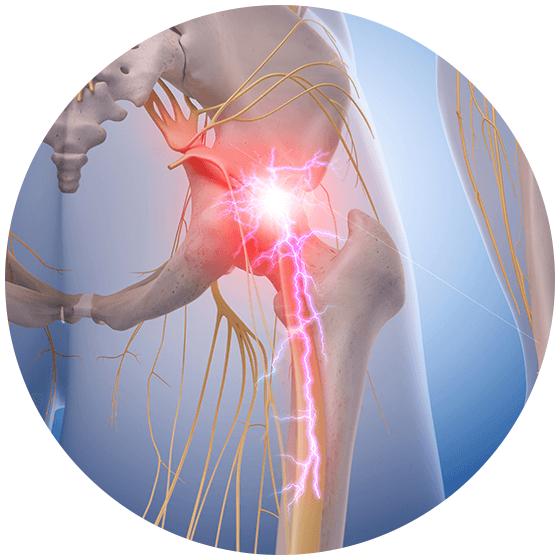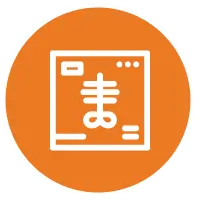Sciatica Treatment in New Jersey & New York
Get expert relief from sciatic nerve pain with our board-certified spine specialists. We offer advanced diagnostics, non-surgical therapies, and minimally invasive treatments for lasting sciatica relief.

What is Sciatica?
If you’re experiencing sharp, burning pain that starts in your lower back and travels down your leg, you might be suffering from sciatica – and you’re not alone. Thousands of people throughout New Jersey, New York, and the world, deal with sciatic nerve pain every day.
Your sciatic nerve is your body’s main communication line between your brain and your legs, controlling everything from walking and standing to the feeling in your feet. It starts at your lower spine and travels through your buttocks, and runs down the back of each leg all the way to your toes. Moreover, the sciatic nerve is composed of five smaller nerves that branch out from the spinal cord.
Because the sciatic nerve covers so much territory in your body, there are many places where it can get trapped or irritated, causing sciatic nerve pain in your lower back, hip, buttock, thigh, calf, or even your foot. This sciatic pain, or sciatica, can range from a dull ache to excruciating, electric-like sensations that make it impossible to sit, stand, or sleep comfortably.
If you’re dealing with sciatica, you know how this condition can completely take over your life. But here’s the encouraging news: most people with sciatica, even severe cases that haven’t responded to previous treatments, can find significant relief with our specialized, minimally invasive sciatica treatment options. Patients come to our New Jersey and New York locations from throughout the Northeast, across the nation, and even internationally for the most advanced sciatica treatment available.
Sciatica Symptoms and Signs
Our legs and feet are our foundation. When these get disrupted, our whole world can be thrown off balance. The sciatic nerve plays a huge role in this foundation. When our sciatic nerve becomes irritated or pinched, it can lead to excruciating pain and disruptions in one’s daily life.
Recognizing sciatic nerve symptoms early can significantly improve treatment outcomes and prevent the condition from becoming chronic. The most common sciatic nerve pain symptoms include sharp, shooting pain from your lower back down the back of your leg, burning or tingling sensation along the sciatic nerve pathway, numbness or weakness in your affected leg or foot, pain that worsens when sitting, coughing, or sneezing, and difficulty moving your leg or foot due to pain or weakness.
Additional sciatica symptoms may include:
- Lower back pain that radiates down your leg
- Hip pain on the affected side
- Muscle weakness in your leg or foot
- Loss of reflexes in your knee or ankle
- Pins and needles sensation in your leg
- Pain that improves when walking or lying down
- Difficulty standing up from a seated position
- Cramping or burning sensation in your calf
If you notice any of these sciatica symptoms, especially if they persist for more than a few days or worsen over time, it’s important to consult with a qualified sciatica specialist or sciatica doctor. Early intervention can prevent progression and improve long-term outcomes.
Sciatic Nerve Pain Treatment Options
The Advanced Spine Center, with locations in New York and New Jersey, offers comprehensive scoliosis pain treatment options, from conservative management to advanced surgical techniques. Treatment selection depends on factors such as curve severity, patient age, and individual circumstances.
Pain Medication
Oral medications, both over-the-counter and prescription, are often an integral part of recovering from sciatica pain. Medications such as acetaminophen, ibuprofen, and naproxen may be suggested, whereas oral steroids may work best for others.
Injections
A common form of treatment for sciatica, spinal injections target the pain at its source. Administered in intervals, your physician will inject a cortisol steroid directly into the location of irritation. This will help to reduce inflammation, pain, and immobility.
A microdiscectomy is a minimally invasive surgical solution that uses a microscope to visualize, remove, or repair a lumbar herniated disc. Removing a ruptured disc relieves sciatic nerve pain and neurological symptoms by decompressing the pinched sciatic nerve.
A laminectomy is a common form of surgical correction for sciatica that results from spinal stenosis. During this procedure, your surgeon will remove a portion of the lamina (the vertebral sheath that protects the spinal cord) to decompress pinched nerve tissue.
What Causes Sciatica?
Understanding what causes sciatica is crucial for effective treatment. The Harvard Medical School reports that nearly 40% of individuals will experience some degree of sciatic pain in their lifetime, with occurrence increasing with age.
Because of this proximity to other structures, one of the main sources of sciatic pain is a pinching of the sciatic nerve or any of its roots. This pinching can be caused by a variety of factors, including:
- Injury or Trauma
- Bulging or Herniated discs
- Lumbar Spinal Stenosis
- Degenerative Disc Disease or arthritis
- Spondylolisthesis
- Spinal Tumors
Additional factors that can contribute to sciatica include bone spurs, spinal tumors, pregnancy-related changes, obesity, or lack of exercise and movement. In fact, even the type of mattress you sleep on can irritate the sciatic nerve.
What Our Patients Are Saying
The surgeries Dr. Lowenstein performed on me have been life-changing! After 12 years of increasing leg pain I no longer have any. I am able to participate in activities I thought were lost to me. The recuperation was challenging but so worth it! I can not be happier with the results and would highly recommend Dr. Lowenstein to people with serious back pain.
-Karen L. ⭐️⭐️⭐️⭐️⭐️
Dr. Lowenstein, his team and staff were all amazing. They were able to juggle their schedules and the hospitals surgery schedules to be able to fit my daughters surgery in while she was home from college. From pre to post surgery Dr. Lowenstein explained everything that would be going on, what to expect and was always available to answer our questions. His compassion and caring showed in every encounter we had. We could not have found a better person to entrust with our daughters care.
-Rich M. ⭐️⭐️⭐️⭐️⭐️
I had issues with my entire spine. It was not an easy fix. Dr. Jason Lowenstein made sure I knew the variables, he even comforted my mother! His staff made sure I had everything I needed for my job and disability insurance. theAdvanced Spine Center is everything I thought was missing from modern medicine. They still care.
-DVS I. ⭐️⭐️⭐️⭐️⭐️
Minimally Invasive Surgery for Sciatic Nerve Pain
When sciatica surgery is necessary, our local New Jersey sciatica experts specialize in minimally invasive techniques that offer significant advantages over traditional open surgery. Our advanced sciatica surgery approaches provide:
- Smaller Incisions – Reduced scarring and better cosmetic outcomes
- Faster Recovery – Shorter hospital stays and quicker return to activities
- Less Pain – Reduced post-operative discomfort and medication needs
- Better Outcomes – Excellent correction with preserved mobility
With a team of fellowship-trained spine surgeons with extensive experience in both acute and chronic sciatica treatment, including complex cases involving herniated discs, spinal stenosis, and piriformis syndrome, The Advanced Spine Center has helped countless patients regain their quality of life and return to pain-free living.
Why Choose Us for Advanced Spine Care
The Advanced Spine Center in New Jersey is recognized as a leading destination for spine treatment in the nation. Patients choose us for their spine treatment because we offer:

Comprehensive Care
From initial evaluation to post-surgical care, we provide complete spine care. Our multidisciplinary team ensures optimal outcomes for every patient.

Advanced Technology
State-of-the-art imaging, surgical navigation systems, and minimally invasive instruments enable precise, safe spine care with excellent results.

Convenient Location
Easily accessible in New Jersey and New York , our modern facility provides comfortable care in a convenient location. Plus, patients from across the nation, and even world wide, find come to us!
Frequently Asked Questions About Sciatica
Sciatica typically causes sharp, shooting pain that starts in your lower back and travels down your leg. You may also experience numbness, tingling, or weakness. If you have pain that follows the sciatic nerve pathway, especially if it affects one side of your body, you should be evaluated by a sciatica specialist.
Most acute sciatica episodes resolve within 4-6 weeks with appropriate treatment. However, without proper care, symptoms can become chronic and significantly more difficult to treat. Early intervention leads to better outcomes.
While rare, untreated severe sciatica can lead to permanent nerve damage, including loss of sensation or muscle weakness. This is why early treatment is crucial for preventing long-term complications.
Our team of spine experts and sciatica specialists at The Advanced Spine Center includes fellowship-trained specialists who focus specifically on conditions affecting the sciatic nerve. We use the latest diagnostic techniques and offer both conservative and advanced treatment options, ensuring each patient receives personalized care based on their specific needs.
Surgery may be recommended if severe pain persists after 6-8 weeks of conservative treatment, if you develop progressive weakness in your leg, or if you experience bowel or bladder dysfunction (which is a medical emergency requiring immediate attention). Speak with a sciatica specialist at The Advanced Spine Center today to see if a minimally invasive sciatica treatment is right for you.
Ready to Take the Next Step in Your Spine Care?
Don’t let sciatic nerve pain limit your life. Contact the leading sciatic nerve specialists in NJ & NY today!
